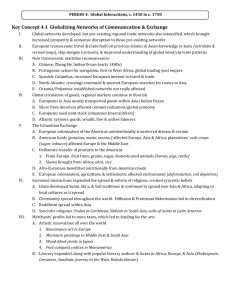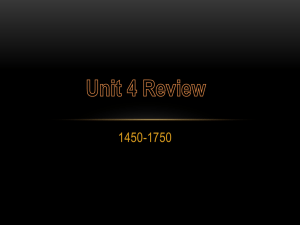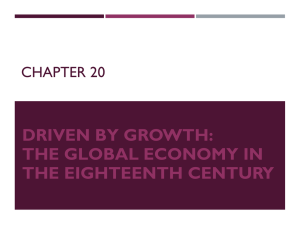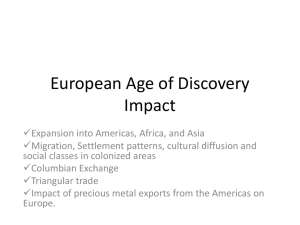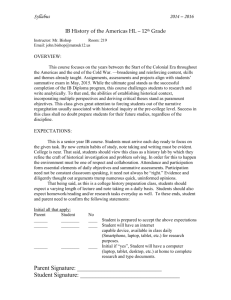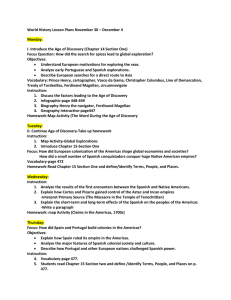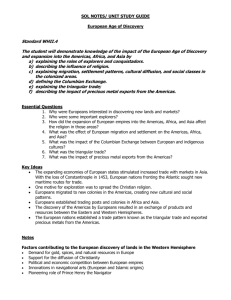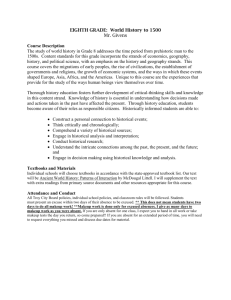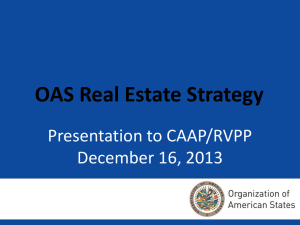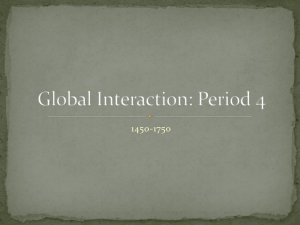AP World History: Global Interactions Key Concepts
advertisement
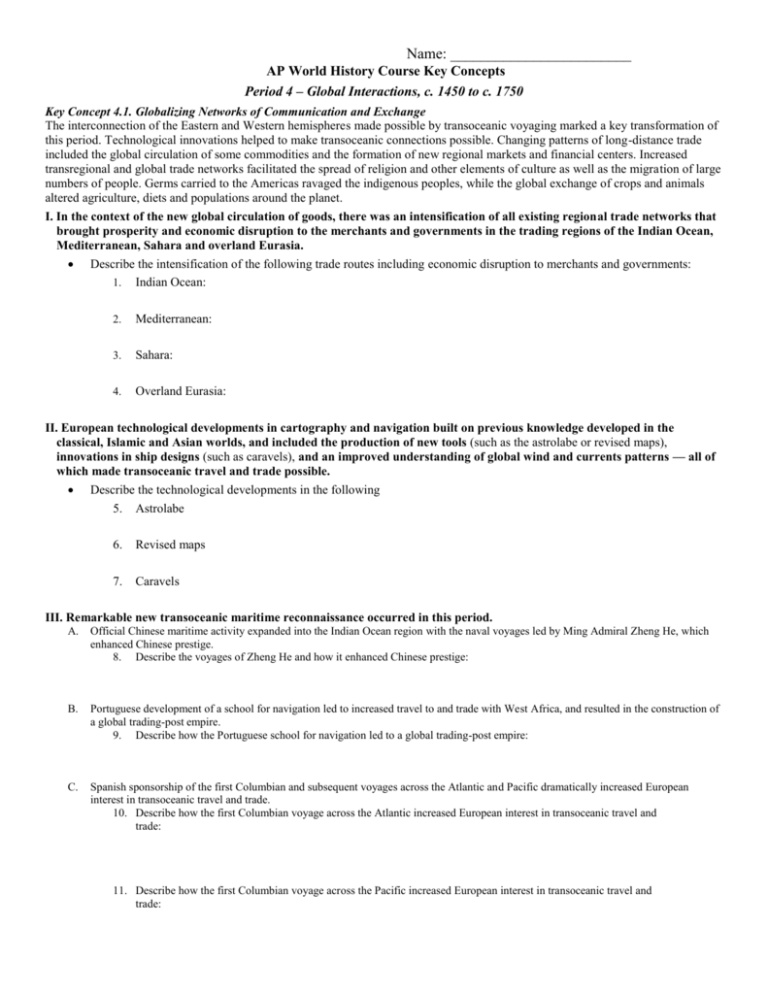
Name: ________________________ AP World History Course Key Concepts Period 4 – Global Interactions, c. 1450 to c. 1750 Key Concept 4.1. Globalizing Networks of Communication and Exchange The interconnection of the Eastern and Western hemispheres made possible by transoceanic voyaging marked a key transformation of this period. Technological innovations helped to make transoceanic connections possible. Changing patterns of long-distance trade included the global circulation of some commodities and the formation of new regional markets and financial centers. Increased transregional and global trade networks facilitated the spread of religion and other elements of culture as well as the migration of large numbers of people. Germs carried to the Americas ravaged the indigenous peoples, while the global exchange of crops and animals altered agriculture, diets and populations around the planet. I. In the context of the new global circulation of goods, there was an intensification of all existing regional trade networks that brought prosperity and economic disruption to the merchants and governments in the trading regions of the Indian Ocean, Mediterranean, Sahara and overland Eurasia. Describe the intensification of the following trade routes including economic disruption to merchants and governments: 1. Indian Ocean: 2. Mediterranean: 3. Sahara: 4. Overland Eurasia: II. European technological developments in cartography and navigation built on previous knowledge developed in the classical, Islamic and Asian worlds, and included the production of new tools (such as the astrolabe or revised maps), innovations in ship designs (such as caravels), and an improved understanding of global wind and currents patterns — all of which made transoceanic travel and trade possible. Describe the technological developments in the following 5. Astrolabe 6. Revised maps 7. Caravels III. Remarkable new transoceanic maritime reconnaissance occurred in this period. A. Official Chinese maritime activity expanded into the Indian Ocean region with the naval voyages led by Ming Admiral Zheng He, which enhanced Chinese prestige. 8. Describe the voyages of Zheng He and how it enhanced Chinese prestige: B. Portuguese development of a school for navigation led to increased travel to and trade with West Africa, and resulted in the construction of a global trading-post empire. 9. Describe how the Portuguese school for navigation led to a global trading-post empire: C. Spanish sponsorship of the first Columbian and subsequent voyages across the Atlantic and Pacific dramatically increased European interest in transoceanic travel and trade. 10. Describe how the first Columbian voyage across the Atlantic increased European interest in transoceanic travel and trade: 11. Describe how the first Columbian voyage across the Pacific increased European interest in transoceanic travel and trade: D. Northern Atlantic crossings for fishing and settlements continued and spurred European searches for multiple routes to Asia. 12. Describe how Northern Atlantic crossings spurred European searches for multiple routes to Asia: E. In Oceania and Polynesia, established exchange and communication networks were not dramatically affected because of infrequent European reconnaissance in the Pacific Ocean. 13. Explain why the Oceania and Polynesia trade routes were not affected by European reconnaissance in the Pacific Ocean: IV. The new global circulation of goods was facilitated by royal chartered European monopoly companies that took silver from Spanish colonies in the Americas to purchase Asian goods for the Atlantic markets, but regional markets continued to flourish in Afro-Eurasia by using established commercial practices and new transoceanic shipping services developed by European merchants. A. European merchants’ role in Asian trade was characterized mostly by transporting goods from one Asian country to another market in Asia or the Indian Ocean region. 14. Describe Europe’s role in Asian trade routes: B. Commercialization and the creation of a global economy were intimately connected to new global circulation of silver from the Americas. 15. Describe how commercialization was connected to the circulation of silver from the Americas: 16. Describe how the global economy was connected to the circulation of silver from the Americas C. Influenced by mercantilism, joint-stock companies were new methods used by European rulers to control their domestic and colonial economies and by European merchants to compete against one another in global trade. 17. Describe the role of joint-stock companies and give an example: D. The Atlantic system involved the movement of goods, wealth, and free and unfree laborers, and the mixing of African, American and European cultures and peoples. Describe how the Atlantic system was involved in the following: 18. Movement of goods: 19. Movement of wealth: 20. Movement of free labor: 21. Movement of unfree labor: 22. Mixing of African, American and European cultures: 23. Mixing of African, American and European people: V. The new connections between the Eastern and Western hemispheres resulted in the Columbian Exchange. A. European colonization of the Americas led to the spread of diseases (such as smallpox, measles or influenza) that were endemic in the Eastern Hemisphere among Amerindian populations and the unintentional transfer of pests (such as mosquitoes or rats). Describe how European colonization led to the spread and transfer of the following and what was the effect: 24. Smallpox: 25. Measles: 26. Influenza: 27. Mosquitoes: 28. Rats: B. American foods (such as potatoes, maize or manioc) became staple crops in various parts of Europe, Asia and Africa, while cash crops (such as cacao or tobacco) were grown primarily on plantations with coerced labor and were exported mostly to Europe and the Middle East in this period. 29. Describe the impact of staple crops on the following: a. Europe: b. Asia: c. Africa: 30. Describe the impact of cash crops: a. Europe: b. Middle East: C. Afro-Eurasian fruit trees, grains, sugar and domesticated animals (such as horses, pigs or cattle) were deliberately brought by Europeans to the Americas, while other foods (such as okra) were brought by African slaves. Describe the impact of the following: 31. Fruit trees: 32. Grains: 33. Sugar: 34. Domesticated animals: 35. Okra: E. Populations in Afro-Eurasia benefitted nutritionally from the increased diversity of American food crops. 36. Describe how the populations in Afro-Eurasia benefitted from American food: F. European colonization and the introduction of European agriculture and settlements practices in the Americas often affected the physical environment through deforestation and soil depletion. What was the consequence of the following: 37. Deforestation: 38. Soil depletion: VI. The increase in interactions between newly connected hemispheres and intensification of connections within hemispheres expanded the spread and reform of existing religions and created syncretic belief systems and practices. A. The practice of Islam continued to spread into diverse cultural settings in Asia and Africa. 39. Describe the spread of Islam as a result of increased interactions: B. The practice of Christianity was increasingly diversified by the Reformation. 40. Describe how Christianity was reformed by the Reformation: C. Buddhism spread within Asia. 41. Describe the spread of Buddhism within Asia as a result of increased interaction: D. Syncretic forms of religion (such as African influences in Latin America, interactions between Amerindians and Catholic missionaries, or Sikhism between Muslims and Hindus in India and Southeast Asia) developed. Describe how the syncretic forms of the following developed: 42. African influences in Latin America: 43. Amerindians and Catholic missionaries: 44. Sikhism between Muslims and Hindus: VII. As merchants’ profits increased and governments collected more taxes, funding for the visual and performing arts, even for popular audiences, increased. A. Innovations in visual and performing arts (such as Renaissance art in Europe, miniature paintings in the Middle East and South Asia, woodblock prints in Japan or post-conquest codices in Mesoamerica) were seen all over the world. Describe the following: 45. Renaissance art in Europe: 46. Miniature paintings in the Middle East and South Asia: 47. Wood-block prints in Japan: 48. Post-conquest codices in Mesoamerica: B. Literacy expanded and was accompanied by the proliferation of popular literary forms in Europe and Asia (such as Shakespeare, Cervantes, Sundiata, Journey to the West or Kabuki). Describe how the following was used to expand literacy: 49. Shakespeare: 50. Cervantes: 51. Sundiata: 52. Journey to the West: 53. Kabuki: Key Concept 4.2. New Forms of Social Organization and Modes of Production Although the world’s productive systems continued to be heavily centered on agricultural production throughout this period, major changes occurred in agricultural labor, the systems and locations of manufacturing, gender and social structures, and environmental processes. A surge in agricultural productivity resulted from new methods in crop and field rotation and the introduction of new crops. Economic growth also depended on new forms of manufacturing and new commercial patterns, especially in long-distance trade. Political and economic centers within regions shifted, and merchants’ social status tended to rise in various states. Demographic growth — even in areas such as the Americas, where disease had ravaged the population — was restored by the 18th century and surged in many regions, especially with the introduction of American food crops throughout the Eastern Hemisphere. The Columbian Exchange led to new ways of humans interacting with their environments. New forms of coerced and semicoerced labor emerged in Europe, Africa and the Americas, and affected ethnic and racial classifications and gender roles. I. Traditional peasant agriculture increased and changed, plantations expanded, and demand for labor increased. These changes both fed and responded to growing global demand for raw materials and finished products. A. Peasant labor intensified in many regions (such as the development of frontier settlements in Russian Siberia, cotton textile production in India or silk textile production in China). How did peasant labor effect the following: 54. Development of frontier settlements in Russian Siberia: 55. Cotton textile production in India: 56. Silk production in China: C. Slavery in Africa continued both the traditional incorporation of slaves into households and the export of slaves to the Mediterranean and the Indian Ocean. 57. Describe how/why slavery in Africa continued the traditional incorporation of slaves into households: 58. Describe how/why slavery in Africa led to the export of slaves to the Mediterranean and Indian Ocean: D. The Atlantic slave trade increased demand for slaves and altered male-female ratios in Africa. 59. Describe how increased demand for slaves affected the male-female ratios in Afica and what was the effect: E. The purchase and transport of slaves supported the growth of the plantation economy throughout the Americas. 60. Describe how the purchase and transport of slaves supported growth of plantation economy in the Americas: F. Spanish colonists transformed Amerindian labor systems (such as introducing the encomienda and hacienda systems or changing the Inca mit’a labor obligation into a forced labor system). 61. Describe the encomienda system: 62. Describe the hacienda system: 63. Describe the changes in the Inc mit’a system: G. Europeans used coerced and semicoerced labor (such as indentured servitude or impressment). 64. Describe indentured servitude: 65. Describe impressments: II. As new social and political elites changed, they also restructured new ethnic, racial and gender hierarchies. A. Both imperial conquests and widening global economic opportunities contributed to the formation of new political and economic elites (such as the Manchus in China, Creole elites in Spanish America, European gentry or urban commercial entrepreneurs in all major port cities in the world). Describe how each of the following was involved with global economic opportunities and the formation of new political and economic elites: 66. Manchus in China: 67. Creole elites in Spanish America: 68. European gentry or urban commercial entrepreneurs in port cities(give an example of at least one): B. The power of existing political and economic elites (such as the zamindars in the Mughal Empire, the nobility in Europe or the daimyo in Japan) fluctuated as they confronted new challenges to their ability to affect the policies of the increasingly powerful monarchs and leaders. Describe how the following elites fluctuated as they confronted new challenges: 69. Zamindars in Mughal Empire: 70. Nobility in Europe: 71. Daimyo in Japan: C. Some notable gender and family restructuring occurred, including the demographic changes in Africa that resulted from the slave trades (as well as the dependence of European men on Southeast Asian women for conducting trade in that region or the smaller size of European families). 72. Describe how the gender and family restructuring caused dependence of European men: D. The massive demographic changes in the Americas resulted in new ethnic and racial classifications (such as mestizo, mulatto or Creole). 73. Discuss the classification of mestizo: 74. Discuss the classification of mulatto: 75. Discuss the classification of Creole: Key Concept 4.3. State Consolidation and Imperial Expansion Empires expanded and conquered new peoples around the world, but they often had difficulties incorporating culturally, ethnically and religiously diverse subjects, and administrating widely dispersed territories. Agents of the European powers moved into existing trade networks around the world. In Africa and the greater Indian Ocean, nascent European empires consisted mainly of interconnected trading posts and enclaves. European empires in the Americas moved more quickly to settlement and territorial control, responding to local demographic and commercial conditions. Moreover, the creation of European empires in the Americas quickly fostered a new Atlantic trade system that included the trans-Atlantic slave trade. Around the world, empires and states of varying sizes pursued strategies of centralization, including more efficient taxation systems that placed strains on peasant producers, sometimes prompting local rebellions. Rulers used public displays of art and architecture to legitimize state power. African states shared certain characteristics with larger Eurasian empires. Changes in African and global trading patterns strengthened some West and Central African states — especially on the coast; this led to the rise of new states and contributed to the decline of states on both the coast and in the interior. I. Rulers used a variety of methods to legitimize and consolidate their power. A. Visual displays of political power (such as monumental architecture, urban plans, courtly literature or the visual arts) helped legitimize and support rulers. Describe how the following visual displays of political power help legitimize and support rulers 76. Monumental architecture: 77. Urban plans: 78. Courtly literature: 79. Visual arts: B. Rulers used religious ideas (such as European notions of divine right, the Safavid use of Shiism, the Mexica or Aztec practice of human sacrifice, the Songhai promotion of Islam or the Chinese emperors’ public performance of Confucian rituals) to legitimize their rule. Describe how each of the following helped rulers legitimize their rule: 80. European notions of divine right: 81. Safavid use of Shiism: 82. Mexica or Aztec practice of human sacrifice: 83. Songhai promotion of Islam 84. Chinese emperors’ public performance of Confucian rituals: C. States treated different ethnic and religious groups in ways that utilized their economic contributions while limiting their ability to challenge the authority of the state (such as the Ottoman treatment of non-Muslim subjects, Manchu policies toward Chinese or the Spanish creation of a separate “República de Indios”). Describe how each of the following was utilized by their states: 85. Ottoman treatment of non-Muslim subjects: 86. Manchu policies toward Chinese: 87. Spanish creation of a separate “Republica de Indios”: E. Recruitment and use of bureaucratic elites, as well as the development of military professionals (such as the Ottoman devshirme, Chinese examination system or salaried samurai), became more common among rulers who wanted to maintain centralized control over their populations and resources. How did the rulers maintain centralized control over the following: 88. Ottoman devshirme: 89. Chinese examination system: 90. Salaried samurai: F. Rulers used tribute collection and tax farming to generate revenue for territorial expansion. 91. Describe how rulers used tribute collection and tax farming to generate revenue for territorial expansion: II. Imperial expansion relied on the increased use of gunpowder, cannons and armed trade to establish large empires in both hemispheres. A. Europeans established new trading-post empires in Africa and Asia, which proved profitable for the rulers and merchants involved in new global trade networks, but these empires also affected the power of the states in interior West and Central Africa. Describe how the Europeans affected the power of the following: 92. Trading-posts in Africa: 93. Trading-posts in Asia: 94. West Africa: 95. Central Africa: B. Land empires, including the Manchus, Mughals, Ottomans and Russians, expanded dramatically in size. Describe the cause, effect, and consequence of the expansion of the following: 96. Manchus: 97. Mughals: 98. Ottomans: 99. Russians: C. European states, including Portugal, Spain, the Netherlands, France and Britain, established new maritime empires in the Americas. Describe the new maritime empires that were established in the Americas by: 100. Portugal: 101. Spain: 102. Netherlands: 103. France: 104. Britain: III. Competition over trade routes (such as Omani-European rivalry in the Indian Ocean or piracy in the Caribbean), state rivalries (such as the Thirty Years War or the Ottoman-Safavid conflict) and local resistance (such as bread riots) all provided significant challenges to state consolidation and expansion. Describe how each of the following provided significant challenges to state consolidation and expansion: 105. Omani-European rivalry in the Indian Ocean: 106. Piracy in the Caribbean: 107. Thirty Years War: 108. Ottoman-Safavid conflict: 109. Bread riots:
